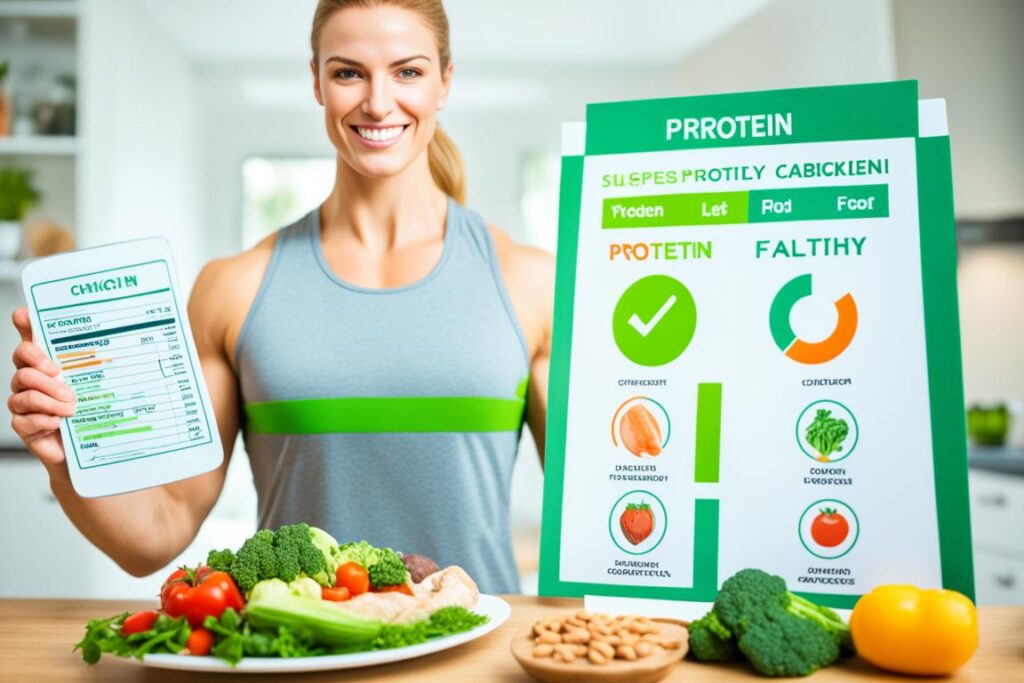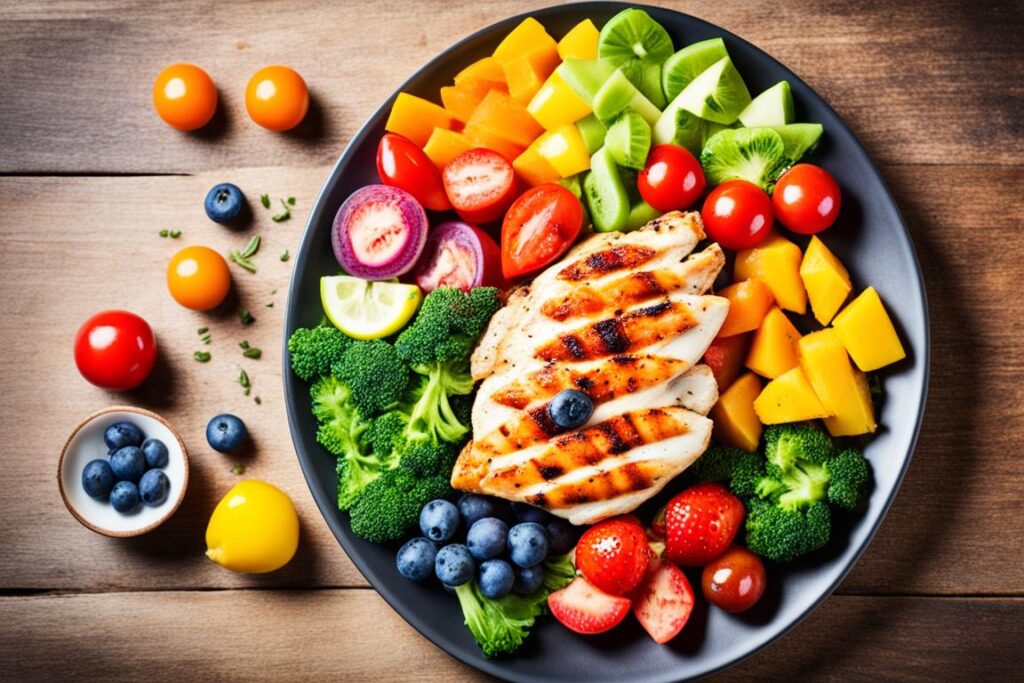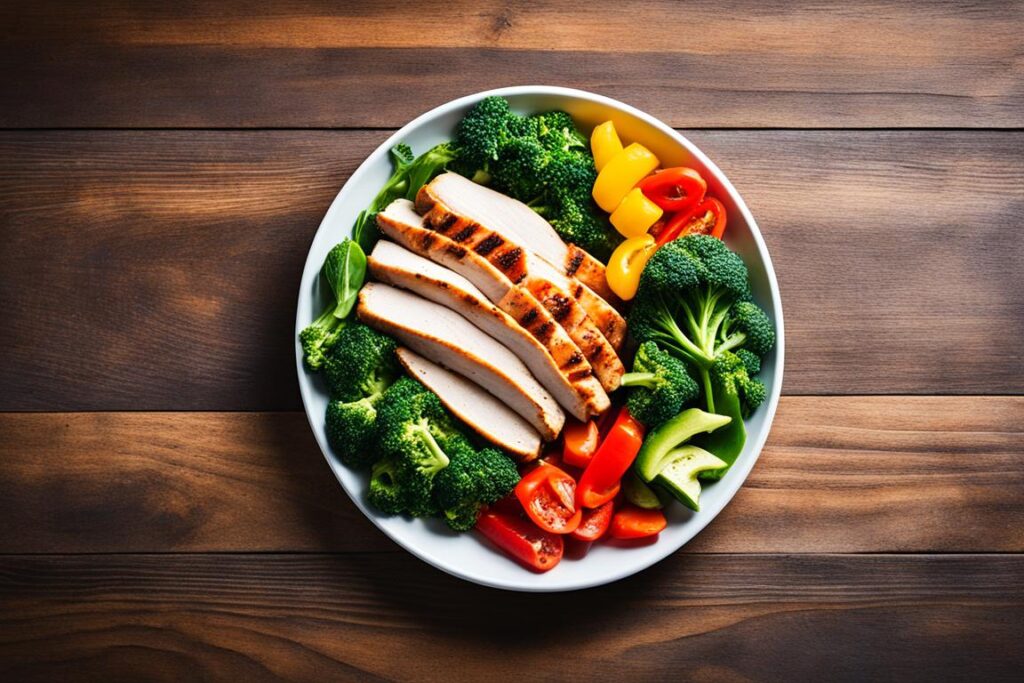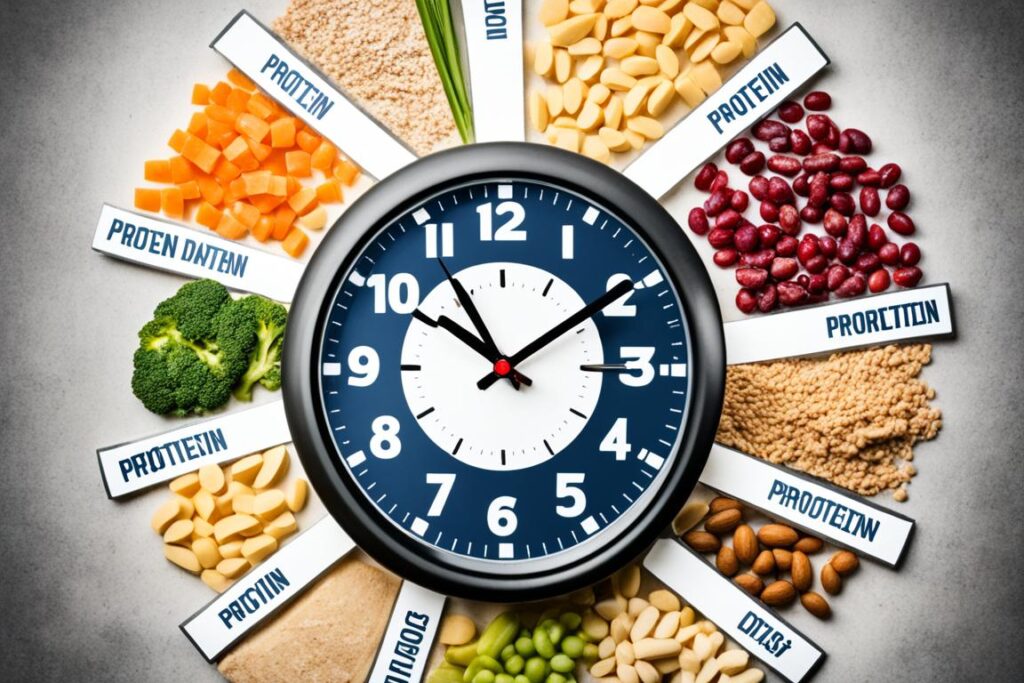Did you know that protein requirements are often too low? Studies across various groups have shown this. If you’re trying to lose weight, knowing about protein is key. It’s more than a nutrient; it’s a building block for your muscles and helps with weight control.
Adding enough protein to your diet can really help with losing fat. Studies show that eating more protein, especially with strength training, can boost muscle and strength. Plus, a diet rich in protein can increase your metabolism. This happens because digesting protein burns more calories.
To make the most of protein for fat loss, it’s important to know how much you need. You also need to know where to get your protein from. This guide will help you figure all that out, making your fat loss journey better.
Key Takeaways
- Protein requirements are often underestimated but play a critical role in fat loss.
- Higher protein intake boosts metabolism and supports muscle mass preservation.
- Combining high protein with resistance training improves body composition.
- Effective fat loss can be achieved with 25-35% of daily caloric intake from protein.
- Protein has a higher thermic effect compared to carbs and fats, enhancing calorie burn.
Understanding Protein and Its Role in Fat Loss
Protein is key in managing weight because it affects appetite, metabolism, and body shape. High-protein diets help with weight loss by influencing hormones that control hunger. They increase hormones that make you feel full and reduce the hunger hormone.
A study review found that high-protein, low-fat diets lead to more weight loss than diets with normal protein levels. This happens partly because the body uses more energy to digest protein than carbs or fats. This means even when you’re not moving, your body burns more calories.
Research also shows that high-protein diets are good for long-term health. They reduce hunger, cut calorie intake, and help keep weight off. Plus, they prevent gaining back the weight after losing it.
Protein is also important for keeping muscle mass while losing weight, especially with regular exercise. Studies show that diets high in protein help change metabolism and hunger signals. This helps with long-lasting weight loss and body improvements.
The National Health and Nutrition Examination Survey talks about protein intake in the U.S. Eating enough protein helps with metabolism, feeling full, and having a better body shape for everyone.
Besides aiding in weight loss, protein is also great for bone health and meeting nutritional needs. This shows the wide-ranging benefits of eating enough protein.
| Diet Type | Effect on Weight Loss |
|---|---|
| High-Protein, Low-Fat | More Significant Weight Loss |
| Standard-Protein, Low-Fat | Moderate Weight Loss |
How Much Protein Do You Need for Effective Fat Loss?

Getting the right amount of daily protein is key for losing fat effectively. It ensures your diet is optimized, helps keep muscle while losing fat, and helps you meet your weight loss goals.
Recommended Dietary Allowance (RDA)
The RDA for protein is 0.8 grams for each kilogram of your body weight if you don’t exercise much. But if you want to lose fat, you might need more. A higher intake of 1 to 1.2 grams per kilogram is advised for better fat loss. High-protein diets, making up 25-30% of your daily calories, are great for shedding fat and keeping it off.
Active vs. Sedentary Lifestyles
How much protein you need changes if you’re active or not. Active people, like athletes, should aim for 1.2 to 2.0 grams per kilogram each day. This supports muscle and helps lose fat when eating fewer calories. But, if you’re not very active, sticking to between 0.8 to 1 gram is enough for good fat loss.
Best Protein Sources for Weight Loss
Add the best proteins for weight loss to your diet to reach your fitness goals. Foods from various groups offer high-quality protein. This way, you enjoy taste and nutrition without missing out.
Lean Meats
Lean meats are top choices for losing weight. Chicken breast has 22.5g of protein per 100g, while turkey breast offers 25.6g per 85g. They are low in fat, perfect for weight loss plans.
Fish like tuna and salmon are also great. Tuna gives you 32g of protein per 4-ounce serving, and salmon packs 39.3g per 178g. They are full of protein and healthy fats.
Plant-Based Proteins
Vegans and vegetarians have plenty of plant-based protein options. For example, black beans have 15.2g of protein per cup. Lentils offer 18g per 1-cup serving. These options are loaded with fiber and nutrients.
Tempeh is another good choice with 20.3g of protein per 100g. Spirulina shines with 64.4g per cup, making it an amazing source of protein for diet diversity.
Dairy Products
Dairy is key for protein in weight loss diets. Nonfat Greek yogurt has about 22g of protein per cup. Cottage cheese gives you 12.5g per 113g serving, ideal for snacks or breakfast.
Skyr, from Iceland, has about 26g of protein per cup. These dairy products not only offer protein but also essential nutrients like calcium.
| Protein Source | Serving Size | Protein Content |
|---|---|---|
| Chicken Breast | 100g | 22.5g |
| Turkey Breast | 85g | 25.6g |
| Tuna | 4-ounce (cooked) | 32g |
| Salmon | 178g | 39.3g |
| Black Beans | 1 cup | 15.2g |
| Tempeh | 100g | 20.3g |
| Greek Yogurt | 1 cup (nonfat) | 22g |
| Cottage Cheese | 113g | 14.5g |
| Skyr | 1 cup | 26g |
Benefits of a Protein-Rich Diet for Weight Loss
Eating more protein rich diet for weight loss has lots of good points, like better hunger control. It really helps your metabolism speed up. This means you could burn an extra 260 calories a day than if you ate less protein. Such a boost is key for losing weight and keeping it off for good.
Protein is also great for keeping muscle while you lose weight. During weight loss, people might lose 20-30% of their muscle, which isn’t good. By eating more protein and doing exercises like weight lifting, you can lose fat without losing muscle.
Raising protein to 30% of what you eat each day could help you eat 441 fewer calories. This was seen in overweight women over 12 weeks, leading to an 11-pound weight loss. Another study found that eating 25% protein cut cravings by 60% and reduced late-night snacking by half in overweight men.
Protein helps in getting a better body shape too. In one study, those on a high-protein diet lost more body fat over a year than those on a regular protein diet. High protein eating makes your body better at burning fat while keeping muscle mass.
More protein can lower blood pressure and help muscles heal after an injury. It also slows down muscle loss as people get older, which is important for staying strong as we age.
Choosing a protein rich diet for weight loss is not just about losing weight. It’s also about improving your overall health and how your body works. The many benefits of high protein intake show why it’s a smart choice for a healthy lifestyle.
How Protein Affects Appetite and Satiety

Protein plays a big role in feeling full and losing fat. It helps control how much we eat and snacks we grab. This makes it a crucial part of our diet.
Hormonal Impact of Protein
Protein has a big effect on our hunger hormones. Eating lots of protein can make us feel fuller by releasing certain hormones. These hormones tell our brain we’re full, helping us eat less and stick to our diet.
Protein’s Effect on Hunger Hormones
It also reduces hunger by lowering ghrelin, our hunger hormone. With less ghrelin, we feel hungrier less often. This means we eat less, helping with weight loss. Studies show high-protein diets can improve health in the long run.
| Hormones | Effect | Protein’s Role |
|---|---|---|
| GLP1 | Increases satiety | Stimulated by high protein intake |
| PYY | Increases satiety | Released in response to protein |
| Ghrelin | Increases hunger | Decreased by protein consumption |
The Thermic Effect of Protein and Its Impact on Metabolism
The term “thermic effect of food” (TEF) talks about the energy we use to digest food. This can be about 10% of the calories we eat if we follow a balanced diet. It’s important to know about this to make a diet that helps in losing fat and keeps our metabolism good.
Understanding the Thermic Effect of Food
Protein burns more calories than fats and carbs when you digest it. Studies show that protein’s thermic effect is 20-30%. This is way more than that of carbs (5-15%) and fats (5-10%). Eating protein makes our body work harder to digest it. This helps in burning more calories.
Comparison with Carbs and Fats
Protein does a better job at increasing your metabolic rate than carbs or fats. Carbs have a thermic effect of 5-15% depending on the type. Fats are easier to digest, so their thermic effect is about 5-10%. Eating more protein, like lean meats, fish, eggs, and legumes, helps keep your metabolism up. It also supports weight loss.
| Macronutrient | Thermic Effect Range |
|---|---|
| Protein | 20-30% |
| Carbohydrates | 5-15% |
| Fats | 5-10% |
Adding more protein to your diet helps in using nutrients better and burns more energy. Having protein-rich foods regularly and keeping a good balance of nutrients can help you manage your weight better. It also keeps your metabolism working well.
Creating a High-Protein Meal Plan for Fat Loss

Planning your meals well is key to a high protein diet for fat loss. A good meal plan balances protein, carbs, and fats to meet nutritional needs. It also keeps your meals interesting.
Sample Meal Plans
Adding high protein foods to your meals aids in fat loss. Using USDA data, we’ve got meal plans with over 50 grams of protein and 30 grams of fiber. These will help in planning for weight loss:
| Meal Plan Design | Calories | Protein (g) | Carbohydrates (g) | Fiber (g) | Fat (g) | Sodium (mg) |
|---|---|---|---|---|---|---|
| Plan 1 | 1,200 | 77 | 135 | 22 | 41 | 1,598 |
| Plan 2 | 1,228 | 64 | 130 | 27 | 50 | 1,315 |
| Plan 3 | 1,212 | 87 | 112 | 27 | 47 | 1,265 |
| Plan 4 | 1,225 | 81 | 116 | 26 | 50 | 1,502 |
| Plan 5 | 1,215 | 74 | 106 | 27 | 58 | 1,740 |
| Plan 6 | 1,217 | 90 | 136 | 39 | 39 | 1,278 |
| Plan 7 | 1,208 | 70 | 144 | 30 | 41 | 1,743 |
Snacking on High-Protein Foods
Eating protein-rich snacks between meals helps you stay full. Try Greek yogurt with about 20 grams of protein per cup or a quarter-cup of peanuts for 9 grams of protein. These snacks are great for a high protein diet and keep hunger away.
These snacks, along with careful meal planning, help manage your fat loss protein intake. They ensure you meet your dietary needs for weight loss.
Timing and Distribution of Protein Intake Throughout the Day

Eating protein consistently is key for muscle growth and fat loss. Research shows that both young and old people benefit from moderate amounts of high-quality protein. This helps build muscle effectively.
Having protein at regular meal times is very important. Studies have found that older adults need more protein than younger ones to build muscle. Thus, spreading out fat loss protein intake through the day is essential for muscle building.
Spreading out fat loss protein intake is really important. Research found that older adults who evenly spread their protein intake had stronger muscles. However, another study noted that spreading protein did not always increase muscle size in healthy older adults. Yet, it still brought many health benefits.
Let’s look at some key findings:
- Eating protein-rich meals evenly through the day helps with metabolism and improves body shape better than eating protein at random times.
- A study in 2019 showed that getting enough protein at meals could lower the risk of weakness in older people.
- Regular protein eating matches our body’s ongoing need for amino acids. These help fix tissues and keep our metabolism going strong.
This table shows how much protein you should eat every day to keep muscles strong, according to different studies:
| Age Group | Minimum Protein Intake (g/kg) | Optimal Protein Intake (g/kg) |
|---|---|---|
| Young Adults | 0.8 | 1.2 |
| Older Adults | 1.0 | 1.6 |
| Active Individuals | 1.2 | 2.2 |
Planning when and how much protein to eat every day is huge for losing fat, keeping muscles strong, and staying healthy.
Comprehensive Guide to Protein and Fat Loss
Understanding how protein affects fat loss is key. You need to know how much protein to eat daily. For a 150-pound person, this means 40 to 55 grams of protein each day.
The US Dietary Guidelines recommend getting 10% to 35% of your calories from protein. On a 2,000-calorie diet, that’s 50 to 175 grams of protein every day. Eating more protein, like 30% of your calories, can help you eat 450 fewer calories a day. Studies show for weight loss, 2.3 to 3.1 grams of protein per kilogram of your lean body mass works well.
To lose weight with protein, match your intake to your energy needs. Try eating 30% of your calories as protein, or about 1 gram per pound of body weight daily. This helps with losing weight and keeping muscle. Adults usually get 10%–15% of their calories from protein, around 60 grams a day. But going up to 35% can boost weight loss and muscle growth.
The type of protein you eat matters too. Animal proteins like lean meats and seafood are absorbed better than plant proteins. Make sure your diet has a mix of protein sources, focusing on lean and healthy options.
When you eat protein is also important for losing fat. Protein has a higher thermic effect, meaning it boosts metabolism more than carbs do. A study found that a high-protein meal doubles your metabolic boost compared to a high-carb meal.
| Diet Type | Protein (%) | Carbohydrates (%) | Fat (%) | Calories Per Day |
|---|---|---|---|---|
| Standard U.S. Diet | 16% | 48% | 33% | 2,000 |
| High-Protein Diet | 30-40% | 40-50% | 20-30% | 1,600-2,000 |
| Ketogenic Diet | 6% | 4% | 90% | 1,500-2,000 |
Pairing protein with regular exercise is vital for keeping muscle and boosting metabolism. Understand these tips to use protein for weight loss and better health.
Potential Risks and Considerations of High-Fat Loss Protein Intake
Eating more protein helps with weight loss and feeling full. However, it’s good to know the risks. Eating too much protein can be hard on the kidneys, especially if there’s already a kidney issue. Also, too much from red or processed meats can raise bad cholesterol and up heart disease risk.
Sticking to a high protein diet might cause you to miss out on other important nutrients. If you focus too much on protein, you might not eat enough high-fiber foods like whole grains, fruits, and veggies. There’s also evidence that too much meat protein can lead to bone problems and kidney stones in some people.
To avoid these issues, pick the right kinds of protein like soy, beans, nuts, fish, and lean meats. Always talk to a doctor before starting a high-protein diet, especially if you have health problems. A balanced diet with enough fiber and careful protein watching is key to staying healthy.
FAQ
Q: What is the recommended dietary allowance (RDA) for protein?
Q: How does fat loss protein intake differ for active vs. sedentary lifestyles?
Q: What are the best protein sources for weight loss?
Q: How does a protein-rich diet contribute to weight loss?
Q: How does protein affect appetite and satiety?
Q: What is the thermic effect of protein, and how does it impact metabolism?
Q: How should you structure a high-protein meal plan for fat loss?
Q: Is the timing and distribution of fat loss fat loss protein intake important?
Q: What are potential risks and considerations of a high-fat loss protein intakeprotein intake?
Source Links
- Examine.com
- Mastering Your Macros: A Comprehensive Guide to Weight Loss
- How Protein Can Help You Lose Weight Naturally
- How Much Protein Do You Need Daily? Ideal fat loss protein intake for Muscle Growth, Weight Loss and Managing Chronic Conditions
- High-Protein Low-Calorie Meal Plan Created by a Dietitian: 1,200 Calories
- Protein Distribution and Muscle-Related Outcomes: Does the Evidence Support the Concept?
- Transition to a more even distribution of daily fat loss protein intake is associated with enhanced fat loss during a hypocaloric & physical activity intervention in obese older adults
- Adverse Effects Associated with Protein Intake above the Recommended Dietary Allowance for Adults
- How much protein is too much?